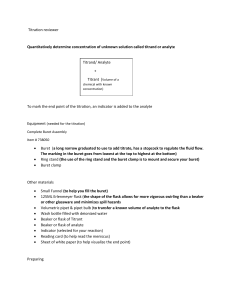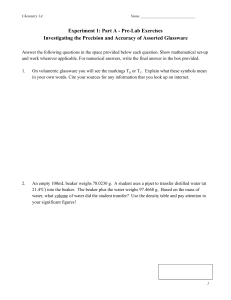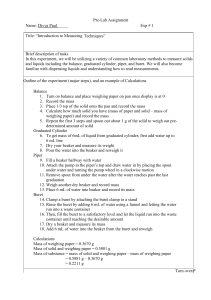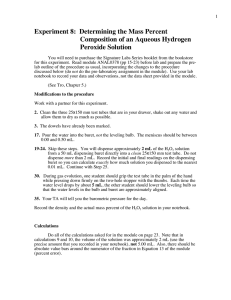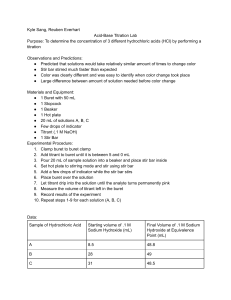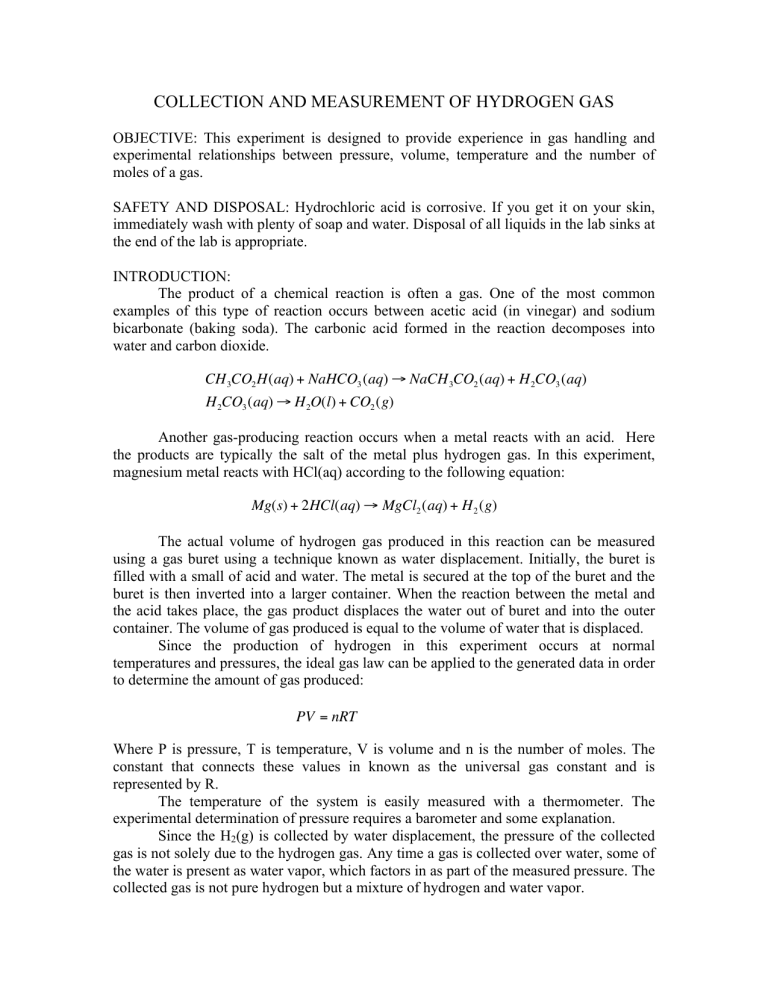
COLLECTION AND MEASUREMENT OF HYDROGEN GAS OBJECTIVE: This experiment is designed to provide experience in gas handling and experimental relationships between pressure, volume, temperature and the number of moles of a gas. SAFETY AND DISPOSAL: Hydrochloric acid is corrosive. If you get it on your skin, immediately wash with plenty of soap and water. Disposal of all liquids in the lab sinks at the end of the lab is appropriate. INTRODUCTION: The product of a chemical reaction is often a gas. One of the most common examples of this type of reaction occurs between acetic acid (in vinegar) and sodium bicarbonate (baking soda). The carbonic acid formed in the reaction decomposes into water and carbon dioxide. CH 3CO2 H(aq) + NaHCO3 (aq) → NaCH 3CO2 (aq) + H 2CO3 (aq) H 2CO3 (aq) → H 2O(l) + CO2 (g) Another gas-producing reaction occurs when a metal reacts with an acid. Here the products are typically the salt of the metal plus hydrogen gas. In this experiment, € magnesium metal reacts with HCl(aq) according to the following equation: Mg(s) + 2HCl(aq) → MgCl2 (aq) + H 2 (g) The actual volume of hydrogen gas produced in this reaction can be measured using a gas buret using a technique known as water displacement. Initially, the buret is filled with a € small of acid and water. The metal is secured at the top of the buret and the buret is then inverted into a larger container. When the reaction between the metal and the acid takes place, the gas product displaces the water out of buret and into the outer container. The volume of gas produced is equal to the volume of water that is displaced. Since the production of hydrogen in this experiment occurs at normal temperatures and pressures, the ideal gas law can be applied to the generated data in order to determine the amount of gas produced: PV = nRT Where P is pressure, T is temperature, V is volume and n is the number of moles. The constant that connects these values in known as the universal gas constant and is represented by R. € The temperature of the system is easily measured with a thermometer. The experimental determination of pressure requires a barometer and some explanation. Since the H2(g) is collected by water displacement, the pressure of the collected gas is not solely due to the hydrogen gas. Any time a gas is collected over water, some of the water is present as water vapor, which factors in as part of the measured pressure. The collected gas is not pure hydrogen but a mixture of hydrogen and water vapor. Only the pressure of H2(g) should be used in the ideal gas law. To correct for the pressure due to the water vapor that is present, we can use Dalton’s Law of Partial Pressure. According to Dalton, the total pressure of a system is equal to the sum of the pressures of the individual gases. Pgas = PH 2 (g ) + PH 2O(g ) Water vapor pressures are temperature dependent. Pwater vapor can be found from Figure 3. € When you finish generating the hydrogen gas, the water levels in your beaker and your buret are likely to be different. This height difference will also result in a pressure difference, which must be corrected for before the ideal gas law can be used effectively. The total pressure of the system is, therefore: Ptotal = Pgas + Pht diff = PH 2 (g ) + PH 2O(g ) + Pht diff € Figure 3. Water Vapor Pressure (mmHg) as a function of Temperature (°C). The equation given relates the temperature in °C to the vapor pressure of water in mmHg. PROCEDURE: Obtain a 50 ml gas buret, a “00” rubber stopper and a 600 ml beaker. Your instructor will demonstrate the set-up of the equipment. Place approximately 450 ml of distilled water in your 600 ml beaker. Obtain a 2 inch piece of magnesium metal. Record the mass of the magnesium metal. The mass should not exceed 0.050 g. Wrap the magnesium metal with string so that it will hang down in the gas buret. Place the gas buret in a buret holder on a ring stand. Add 8-10 ml of 6 M HCl to the gas buret. Using your wash bottle carefully add distilled water down the side of the buret, being careful not to disturb the hydrochloric acid you just placed in the buret. If done properly, the distilled water will remain “on top of” the hydrochloric acid and not mix with it. Continue adding water until the buret is completely filled. Carefully place the magnesium metal so that it hangs several cm down into the gas buret (holding onto the string). Gently insert the stopper into the buret so that the stopper holds the string in place. Check to be sure that an air bubble has not formed at the stopper. If an air bubble is present, remove the stopper, add more distilled water and re-insert the stopper. Using your distilled water bottle, fill the holes of the stopper with distilled water. Place your finger over the stopper holes and invert the gas buret into the beaker so that the top of the buret is below the water level in the beaker. Clamp the buret in place and allow the reaction to proceed. The more dense hydrochloric acid solution will diffuse downward and react with the magnesium metal to produce hydrogen gas. What do you observe suggesting that a reaction is occurring? Your instructor will write the atmospheric pressure on the board for the day. When the reaction is completed, record the distance between the water in the beaker and the solution in the buret (see figure 1, Pht diff). Without moving the buret, read the volume to the nearest ± 0.02 ml on the buret. This is the volume of the hydrogen gas. Take the temperature of the solution in the beaker. The temperature of the solution is equal to the temperature of the gas. Stir the solution in the beaker. Wait one minute and record the temperature again. If the temperature is not the same, repeat the process until it remains unchanged. Record the temperature to the nearest ± 0.1 °C. Rinse out your glassware and the buret and repeat the analysis two more times, recording the exact mass of magnesium for each trial. If the data appears suspect for any reason, a fourth trial must be done. Enter your raw data into the lab computer before you leave. CALCULATIONS: We will look at the data in two different ways: 1. Use the ideal gas law to calculate the actual yield of hydrogen gas and compare it to the theoretical yield based on the moles of magnesium used. 2. Alternatively, using the reasonable assumption for this particular reaction that the yield of hydrogen gas is essentially 100%, the value of R can be determined experimentally from the ideal gas law. You cannot use the theoretical value of R to solve for the experimental R value. The stoichiometrically calculated value for moles of H2 must be used in this instance.

